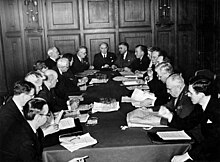Humphrey Hume Wrong
Humphrey Hume Wrong | |
|---|---|
 Humphrey Hume Wrong c. 1915 | |
| Born | September 10, 1894 |
| Died | January 24, 1954(aged 59) |
| Other names | Hume Wrong |
| Education | University of Toronto |
| Known for | Statesman |
| Spouse | Mary Joyce Hutton |
| Children | Dennis Wrongand June Rogers |
Humphrey Hume Wrong(September 10, 1894 – January 24, 1954) was a Canadian historian, professor, careerdiplomat,and Canada's ambassador to theUnited States.
Background and early life
[edit]Wrong was the grandson of Liberal Party leaderEdward Blakeand son of historianGeorge MacKinnon Wrong.At age five he suffered the loss of an eye in an accident.[1]: 111
Hume Wrong graduated from high school atRidley Collegeand was a graduate of theUniversity of Torontowhere he joined TheKappa Alpha Society.During the First World War, Wrong served in theBritish Expeditionary Forcewhere he was sent to the front before being invalided. After the war, he attended theUniversity of Oxfordfor graduate study, and in 1921 became a historyprofessorat theUniversity of Toronto.
Hume was one of five siblings: educator, Margaret Christian Wrong (1887–1948); historian, Oxford academic, and Magdalen College Don,Edward Murray Wrong(1889–1928); British Army officer, Harold Verschoyle Wrong (born 1891, killed in action July 1, 1916, at theBattle of the Somme); and Agnes Honoria Wrong (1903–1995).
Diplomatic appointments
[edit]
In April 1927 he became First Secretary toVincent Massey,head of theCanadian EmbassyinWashington, DC.Wrong joined the newly expanded Canadian Department of External Affairs around the same time as fellow future star diplomatsLester Pearson,Norman Robertson,andHugh Keenleyside;this expansion was engineered byOscar D. Skelton.[1] [2]Wrong served in theLeague of Nationsand in 1938 he represented Canada at theÉvian Conference.
In 1941 he went to Washington whenLeighton McCarthywas made Ambassador, then 71 years old. That made Hume thede factohead of the delegation for Canada in Washington, performing such duties as implementation of theOgdensburg Agreement.
He articulated the principle offunctionalismin 1942 as follows:
- The principle, I think, is that each member of the grand alliance should have a voice in the conduct of the war proportionate to its contribution to the general war effort. A subsidiary principle is that the influence of the various countries should be greatest in connection with those matters with which they are most directly concerned.[1]: 126
The placement ofC. D. Howeon theCombined Production and Resources Board,and of other seats on theCombined Food Board,were evidence of the practice of functionalism. In the estimation ofJack Granatstein,"Canada’s massive war effort, coupled with its tough advocacy of the functionalism principle, made it one of the leaders of the middle powers for a few years during and after the war."[1]: 133
In 1946 Hume Wrong was appointedCanadian Ambassador to the United Statesand he remained in the post until 1953. He was one of the key architects of theNorth Atlantic Treaty,which would give rise toNATO.He later rose to become the Canadian Undersecretary of External Affairs and was named undersecretary toNATO,but died before he could take up the post.
Death
[edit]Wrong is buried atMaclaren CemeteryinWakefield, Quebecwith his fellow diplomats and friendsNorman RobertsonandLester B. Pearson.[3]He is the father of renowned sociologistDennis Wrong,and the grandfather of documentary filmmakerTerence Wrong.
References
[edit]- ^abcdJack Granatstein(1982) Ottawa's Men,Oxford University PressISBN0-19-540386-X
- ^John English(1990)Shadow of Heaven: The Life of Lester Pearson,volume 1, London: Vintage publishers
- ^MacLaren Cemetery.Igougo. Retrieved on 2014-05-26.
